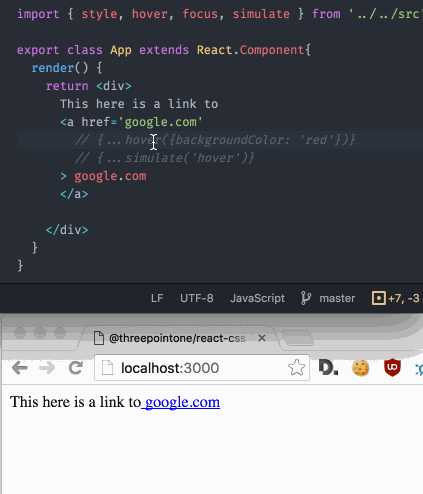In glamor, css rules are treated as values. The css function lets you define these values.
This is a 'rule'
.abc { color: red }These rules can be grouped to form more rules
/* this is a combined rule for .abc */
.abc { color: red }
.abc:hover { color: blue }
html.ie9 .abc span.title { font-weight: bold }
@media(min-width: 300px) {
.abc { font-size: 20 }
} We can write this in javascript
import { css } from 'glamor'
let abc = css({
color: 'red',
':hover': { color: 'blue' },
'html.ie9 & span.title': { fontWeight: 'bold' },
'@media(min-width: 300px)': { fontSize: 20 }
})Combine multiple rules
let combined = css(
abc,
{ color: 'blue', ':after': { content: '"..."'} },
{ ':hover': { textDecoration: 'underline' } },
someOtherRule,
// ...more
)- glamor will make sure that rules are merged in the correct order, managing nesting and precedence for you. (Learn more about selectors and nesting)
- There are a number of helpers to simplify creating rules. See the full list here
- in dev mode, adding a
labelstring prop will reflect its value in devtools. useful when debugging.
You can use these rules with elements
// as classes
<div className={abc}>
hello world
</div>
// or props
<div {...abc}>
hello world
</div>Define fallback values for browsers that don't support features
let gray = css({
color: ['#ccc', 'rgba(0, 0, 0, 0.5)']
})is equivalent to
.gray {
color: #ccc;
color: rgba(0, 0, 0, 0.5)
}append a raw css rule at most once to the stylesheet. the ultimate escape hatch.
// these don't 'return' anything,
// can't nest selectors, do
// *cannot* be combined with other rules.
css.global('html, body', { padding: 0 })
// or if prefer raw css and/or need media queries etc
// send one rule at a time
css.insert('html, body { padding: 0 }')
css.insert('@media print {...}')Note: You have to insert rules one by one! The following will not work in production mode:
css.insert('html, body { padding: 0 } strong{ padding: 10p }')
loads the given font-face at most once into the document, returns the font family name
let family = css.fontFace({
fontFamily: 'Open Sans',
fontStyle: 'normal',
fontWeight: 400,
src: "local('Open Sans'), local('OpenSans'), url(https://fonts.gstatic.com/s/...ff2')",
unicodeRange: "U+0000-00FF, U+0131, ... U+E0FF, U+EFFD, U+F000"
})
// ...
<div {...style({ fontFamily: family })}>
no serifs!
</div>for anything more complicated, use something like typography.js
adds animation keyframes into the document, with an optional name.
let bounce = css.keyframes('bounce', { // optional name
'0%': { transform: 'scale(0.1)', opacity: 0 },
'60%': { transform: 'scale(1.2)', opacity: 1 },
'100%': { transform: 'scale(1)' }
})
// ...
<div {...css({
animation: `${bounce} 2s`,
width: 50, height: 50,
backgroundColor: 'red'
})}>
bounce!
</div>use sparingly! for granular control, use javascript and pencil and paper.
in development, lets you trigger any pseudoclass on an element
toggle speedy mode. By default, this is off when NODE_ENV is development, and on when production.
